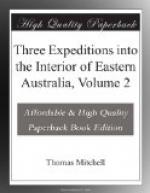The barometer being unusually low, and some long journeys having prevented me from laying down my surveys of the lakes as well as having fatigued the cattle, I halted here with the intention of filling up my maps, refreshing the animals, and reconnoitring the country to the south-west, in which direction a vast extent was unexplored. The river we had endeavoured to trace thus far was now so shut in by ana-branches that it could rarely be seen at all; but I had now brought the survey of it so far upwards that I should be able to trace it, or its several tributaries, downwards upon the same point when returning to the northward, under the western extremities of the Snowy Range. I hoped then also to obtain a better knowledge of the branches composing the Murray than we possessed at this time.
This day I requested Mr. Stapylton to cross the piece of water where we had encamped, and endeavour to find the river in a north-east direction; but he ascertained that the watercourse turned northward, and to the west of north, without entering the river, as far as he traced it. He then returned after having followed its course five miles without falling in with the main stream. His party saw some of the natives who could not be induced to stop by all the calls of Piper.
NATIVE WEIRS FOR FISH.
Mr. Stapylton observed in the channel he traced a net or fence of boughs which the natives had that morning set up; and which showed not only that they expected a flood, but also, from the manner in which it was placed, that the water would flow first up the channel. This circumstance, as already observed, is not unusual in ana-branches where the lower end is naturally on a lower level, having been worn by the currents into a deeper channel there than at the upper end, where the water not unfrequently leaves the river by overflowing its banks in various channels of small depth.
THEIR NETS FOR CATCHING DUCKS.
The natives had left in one place a net suspended across the river between two lofty trees, evidently for the purpose of catching ducks and other waterfowl. The meshes were about two inches wide, and the net hung down to within five feet of the surface of the stream. In order to obtain waterfowl with this net some of the natives proceed up, and others down, the river to scare the birds from other places and, when any flight comes into the net, it is suddenly lowered into the water, thus entangling the birds beneath until the natives go into the water and secure them. Among the first specimens of art manufactured by the primitive inhabitants of these wilds none come so near our own as the net which, even in quality, as well as the mode of knotting, can scarcely be distinguished from those made in Europe. As these natives possess but little besides what was essentially necessary to their existence, we may conclude that they have used spears for killing the kangaroo, stone-axes for cutting out the opossum, and nets for catching birds, or kangaroos, or fish, since their earliest occupation of Australia.* Almost every specimen of art they possess is the result of urgent necessity. Perhaps the iron tomahawk is the only important addition made to their implements during many centuries.




